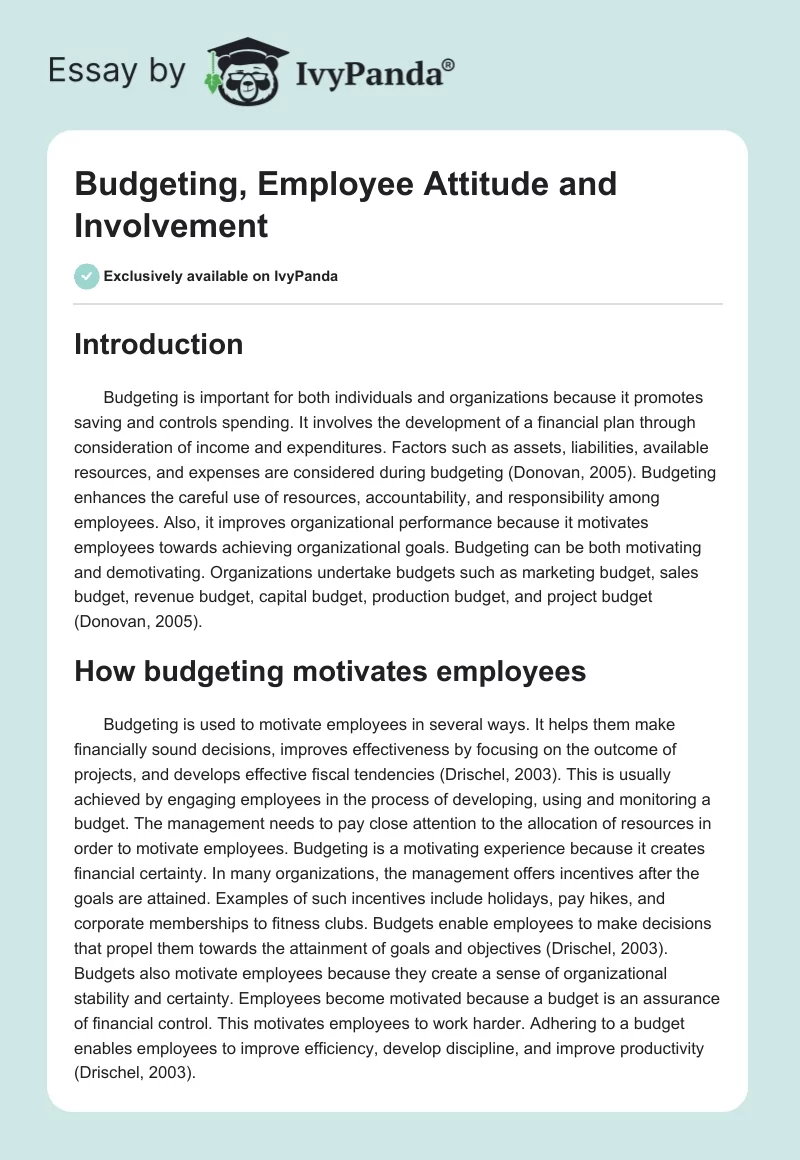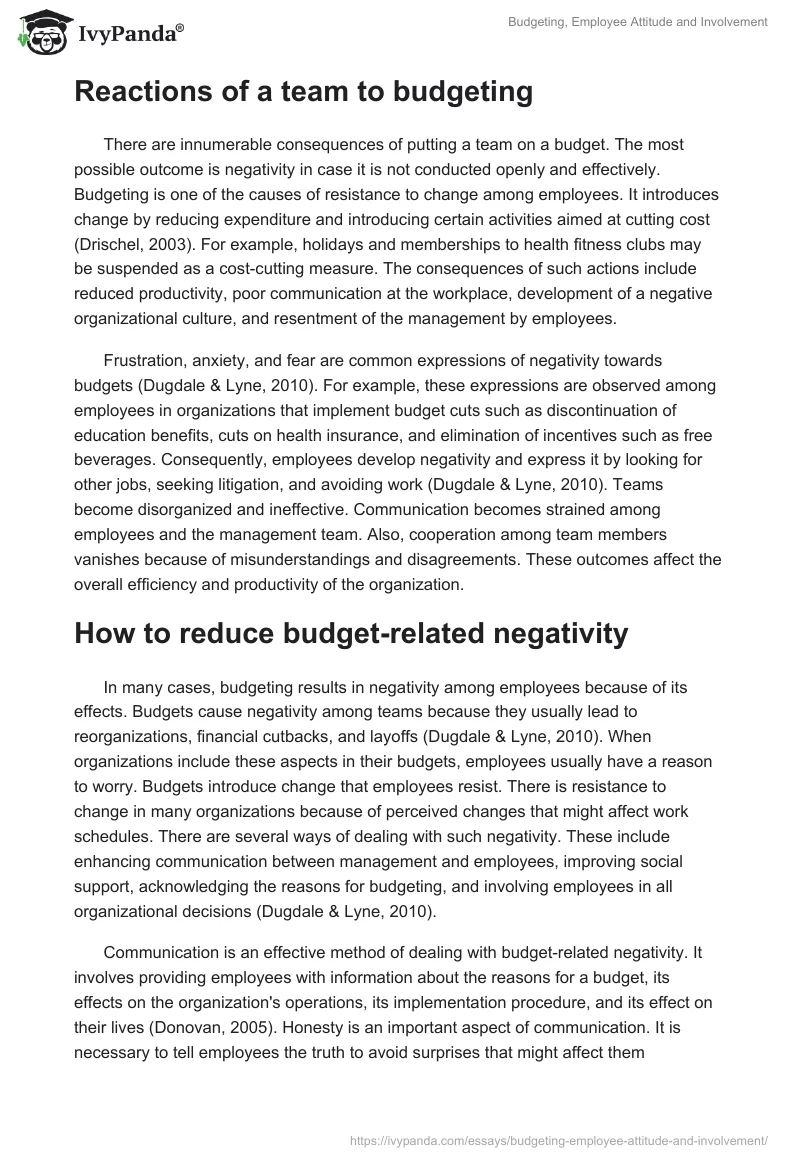Introduction
Budgeting is important for both individuals and organizations because it promotes saving and controls spending. It involves the development of a financial plan through consideration of income and expenditures. Factors such as assets, liabilities, available resources, and expenses are considered during budgeting (Donovan, 2005). Budgeting enhances the careful use of resources, accountability, and responsibility among employees. Also, it improves organizational performance because it motivates employees towards achieving organizational goals. Budgeting can be both motivating and demotivating. Organizations undertake budgets such as marketing budget, sales budget, revenue budget, capital budget, production budget, and project budget (Donovan, 2005).
How budgeting motivates employees
Budgeting is used to motivate employees in several ways. It helps them make financially sound decisions, improves effectiveness by focusing on the outcome of projects, and develops effective fiscal tendencies (Drischel, 2003). This is usually achieved by engaging employees in the process of developing, using and monitoring a budget. The management needs to pay close attention to the allocation of resources in order to motivate employees. Budgeting is a motivating experience because it creates financial certainty. In many organizations, the management offers incentives after the goals are attained. Examples of such incentives include holidays, pay hikes, and corporate memberships to fitness clubs. Budgets enable employees to make decisions that propel them towards the attainment of goals and objectives (Drischel, 2003). Budgets also motivate employees because they create a sense of organizational stability and certainty. Employees become motivated because a budget is an assurance of financial control. This motivates employees to work harder. Adhering to a budget enables employees to improve efficiency, develop discipline, and improve productivity (Drischel, 2003).
Reactions of a team to budgeting
There are innumerable consequences of putting a team on a budget. The most possible outcome is negativity in case it is not conducted openly and effectively. Budgeting is one of the causes of resistance to change among employees. It introduces change by reducing expenditure and introducing certain activities aimed at cutting cost (Drischel, 2003). For example, holidays and memberships to health fitness clubs may be suspended as a cost-cutting measure. The consequences of such actions include reduced productivity, poor communication at the workplace, development of a negative organizational culture, and resentment of the management by employees.
Frustration, anxiety, and fear are common expressions of negativity towards budgets (Dugdale & Lyne, 2010). For example, these expressions are observed among employees in organizations that implement budget cuts such as discontinuation of education benefits, cuts on health insurance, and elimination of incentives such as free beverages. Consequently, employees develop negativity and express it by looking for other jobs, seeking litigation, and avoiding work (Dugdale & Lyne, 2010). Teams become disorganized and ineffective. Communication becomes strained among employees and the management team. Also, cooperation among team members vanishes because of misunderstandings and disagreements. These outcomes affect the overall efficiency and productivity of the organization.
How to reduce budget-related negativity
In many cases, budgeting results in negativity among employees because of its effects. Budgets cause negativity among teams because they usually lead to reorganizations, financial cutbacks, and layoffs (Dugdale & Lyne, 2010). When organizations include these aspects in their budgets, employees usually have a reason to worry. Budgets introduce change that employees resist. There is resistance to change in many organizations because of perceived changes that might affect work schedules. There are several ways of dealing with such negativity. These include enhancing communication between management and employees, improving social support, acknowledging the reasons for budgeting, and involving employees in all organizational decisions (Dugdale & Lyne, 2010).
Communication is an effective method of dealing with budget-related negativity. It involves providing employees with information about the reasons for a budget, its effects on the organization’s operations, its implementation procedure, and its effect on their lives (Donovan, 2005). Honesty is an important aspect of communication. It is necessary to tell employees the truth to avoid surprises that might affect them negatively. It is also important for the management to acknowledge tough financial times and discuss the issue with employees (Donovan, 2005). On the other hand, negativity emanates from ignoring employees during the process of making a budget. To avoid negativity, the management needs to involve employees. This eradicates negativity because employees get an opportunity to give their opinions on the implementation of the budget. Employee motivation can be attributed to their involvement.
Conclusion
Budgeting is an important aspect of an organization’s financial prosperity. It involves the development of a financial plan through consideration of income and expenditures. Aspects considered when making a budget include assets, liabilities, available resources, and expenses. Employees react differently to budgets. Some become motivated while others become de-motivated. Some budget plans include reward schemes for the attainment of goals. Such plans motivate employees and improve their efficiency and productivity. Negativity towards budgets is a common occurrence in many organizations. Employees express negativity through reduced productivity, inefficiency, resentment of management, and absence from work. To eradicate such negativity, organizations should improve communication with employees, foster honesty, and involve employees in budgeting.
References
Donovan, S. (2005). Budgeting. New York: Lerner Publications.
Drischel, J. (2003). Participative Budgeting and its Effects on Employee Motivation. New York: GRIN Verlag.
Dugdale, D., & Lyne, S. (2010). Budgeting Practice and Organizational Structure. New York: Elsevier.


